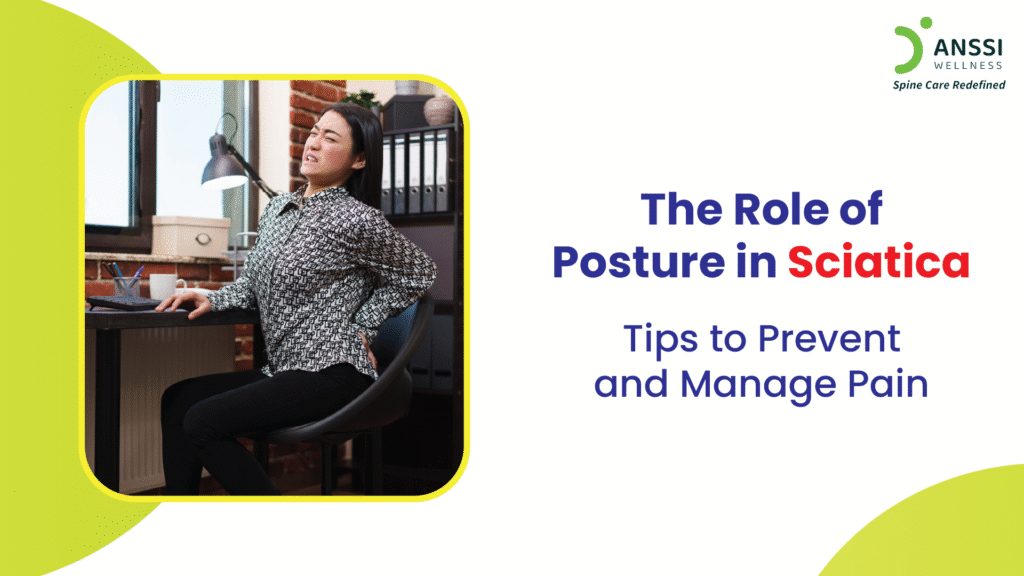Sciatica is a painful condition that occurs when the sciatic nerve, one of the largest nerves in the body, gets compressed or irritated. It typically causes pain that radiates from the lower back down to the hips, buttocks, and legs. While several factors can trigger sciatica, poor posture is one of the most common and often overlooked causes.
Fortunately, making simple adjustments to the way we sit, stand, and move can significantly help in preventing and managing sciatica symptoms.
Understanding the Sciatic Nerve and Its Function
The sciatic nerve originates from the lower spine, specifically the L4 to S3 spinal nerve roots, and extends through the hips and buttocks down each leg. It is responsible for motor and sensory functions of the lower body, including the thighs, calves, and feet.
When this nerve gets compressed, due to conditions like a herniated disc, spinal stenosis, or muscular tightness, it can lead to sciatica. Symptoms often include sharp, burning pain, tingling, numbness, or weakness in the affected leg.
Since the sciatic nerve runs through multiple muscles and joints, any misalignment or pressure in these areas, particularly due to poor posture, can irritate the nerve and worsen the pain.
How Poor Posture Triggers or Worsens Sciatica
Most of us spend hours each day sitting, whether at work, during commutes, or while relaxing at home. When sitting with poor posture, such as slouching forward, hunching over screens, or leaning to one side, the lumbar spine (lower back) is placed under excessive strain. Over time, this pressure can lead to disc compression or muscle imbalances that irritate the sciatic nerve.
Standing incorrectly, such as shifting your weight unevenly on one leg or arching the lower back excessively, also causes misalignment in the spine and pelvis. This not only increases the risk of sciatica but can also prolong or intensify existing symptoms.
Poor posture limits proper circulation and reduces the spine’s natural shock-absorbing ability. As a result, the key symptoms for sciatica, such as increased inflammation, muscle tension, and nerve irritation, may appear.
Posture Correction Tips for Sciatica Relief
Good posture doesn’t mean staying rigid or overly straight. It means keeping the body aligned in a way that puts minimal stress on muscles, joints, and nerves. Here are some posture tips that can help prevent and relieve sciatica pain:
1. Sitting Smart
- Use a chair with good lumbar support.
- Sit with your feet flat on the ground and knees at hip level.
- Do not cross your legs or sit on one foot.
- Keep your back straight and shoulders relaxed.
2. Ergonomic Desk Setup
- Adjust your computer screen to eye level to prevent forward head posture.
- For lower back support, use a rolled towel or cushion.
- Every 30 to 45 minutes, take a moment to stretch and get up.
3. Standing Correctly
- Maintain a shoulder-width distance between your feet and equally distribute your weight.
- Don’t overarch your lower back; instead, engage your core.
- Avoid standing with your hips pushed forward or slouched shoulders.
4. Walking Posture
- Keep your shoulders back and your head up in a tall position.
- Swing your arms naturally and engage your abdominal muscles.
5. Sleeping Posture
- Sleep on your back with a pillow under your knees to reduce pressure on the lower back.
- If you prefer sleeping on your side, place a pillow between your knees.
- Avoid stomach sleeping as it strains the lower spine.
In addition to these posture tips, incorporating gentle exercises like yoga, walking, or swimming can promote flexibility, strengthen core muscles, and reduce nerve compression.
Paying Attention to Worsening Symptoms
While improving posture can offer substantial relief, it may not be enough in all cases. If your sciatica symptoms persist for several weeks or become severe, such as increasing leg weakness, loss of bladder/bowel control, or numbness, it’s important to seek professional help immediately.
A physiotherapist can assess your movement patterns, suggest posture correction exercises, and create a personalised rehabilitation plan. Additionally, non-invasive treatments like non-surgical spinal decompression treatment may be recommended to reduce nerve compression and relieve pressure on the sciatic nerve.
About ANSSI:
ANSSI Wellness focuses on improving the quality of life for patients suffering from spinal issues, aiming to provide relief where other conventional treatments have failed. Through advanced non-surgical spinal decompression treatment, ANSSI is committed to helping patients avoid surgery and recover in a safe, effective, and compassionate environment.
Connect with ANSSI Wellness on LinkedIn, Instagram, and Facebook for expert guidance.




